Philadelphia Fringe Diary 2024 (Updated 10/6/24)
We deep dive into the offbeat, oddball, and often brilliant world of Philadelphia’s independent theatre scene
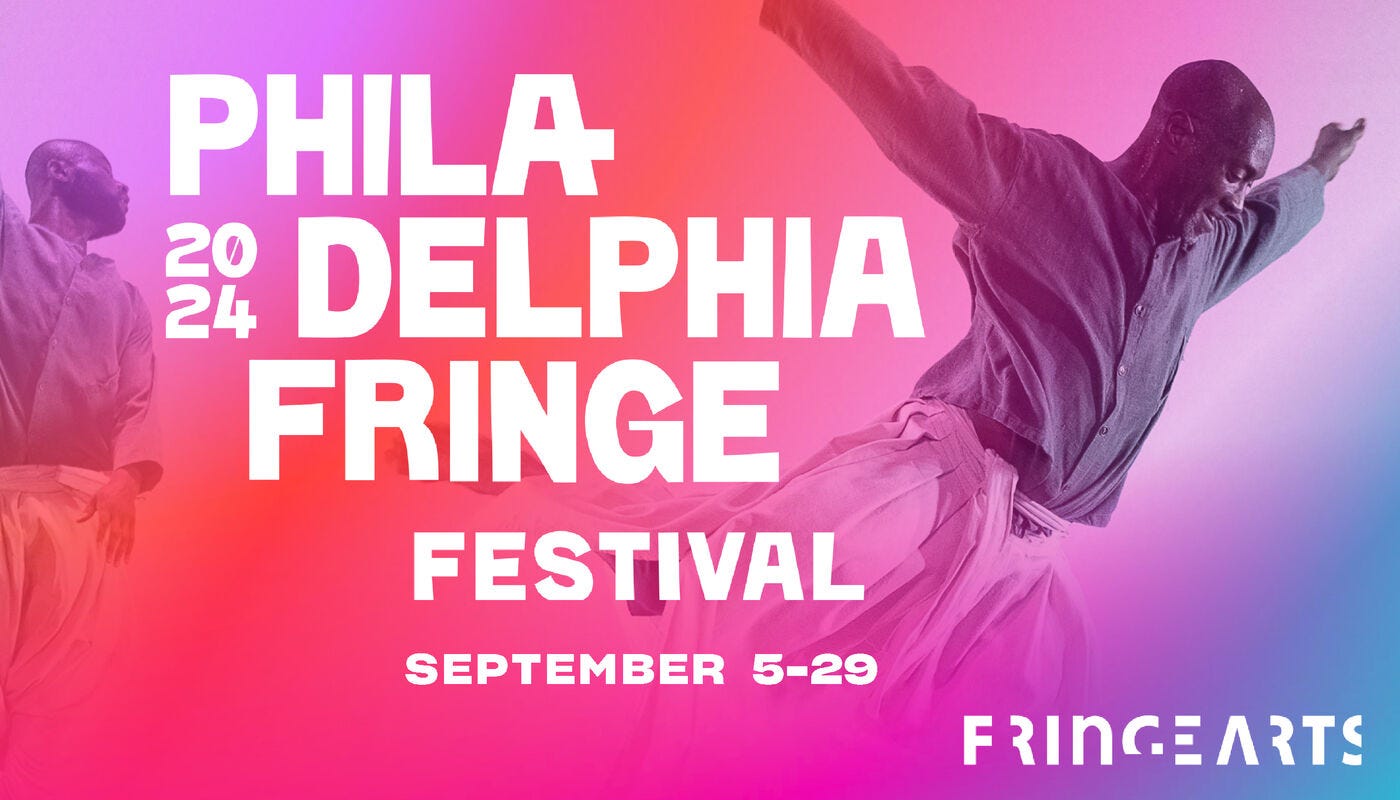
It’s September, and that means it’s Philadelphia Fringe time once again. This year, we’re seeing a lot of new faces, old hands having graduated to larger scale productions, with a few annual Fringe friends returning. Philadelphia continues to be a hub of innovation in immersive, showcasing a diverse set of talents and perspectives. Read on for a sample of some of the strange, and often delightful, immersive offerings of the festival from East Coast Curator Blake Weil and Staff Writer Ed Mylechreest.
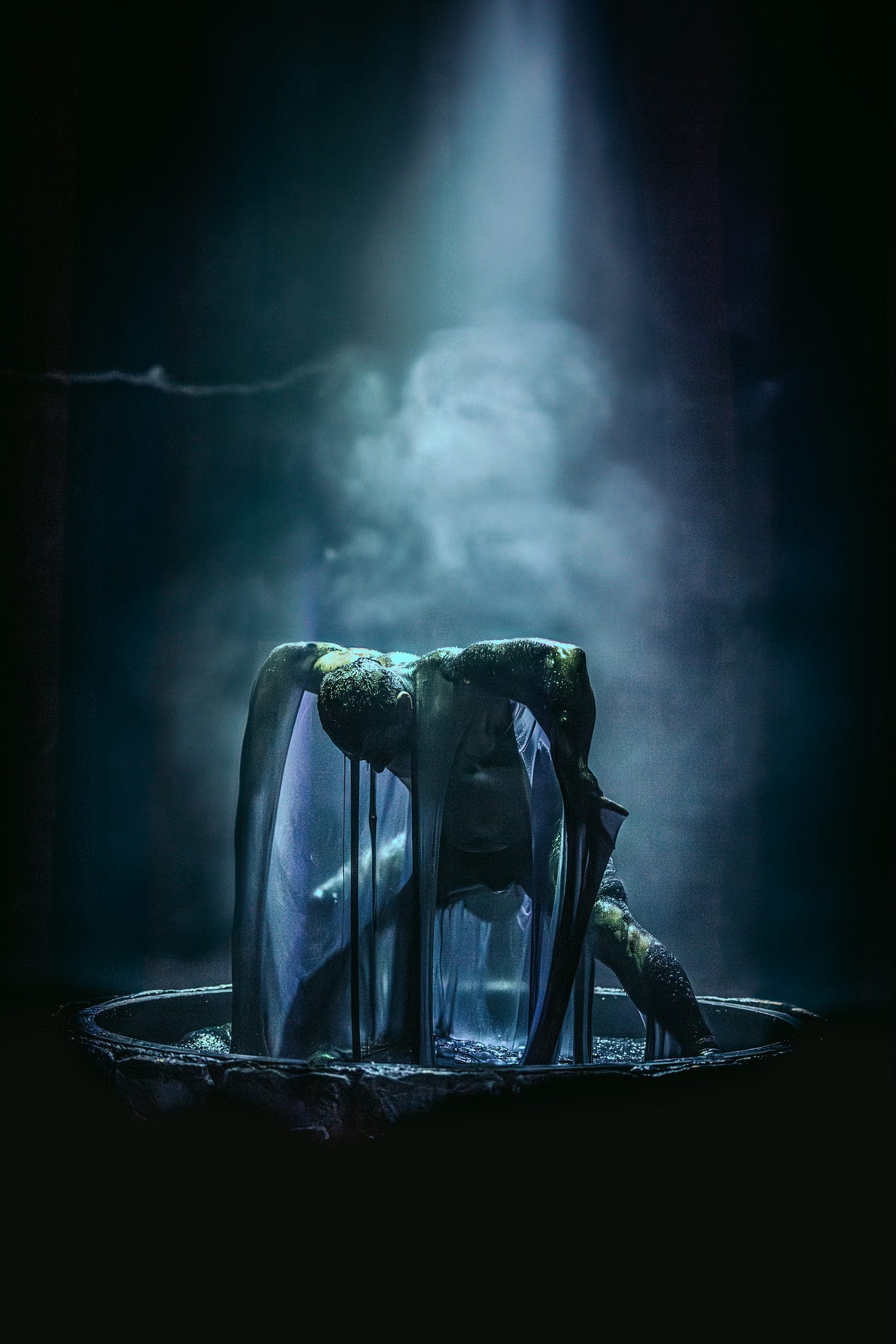
Gunnar Montana Productions; $49+; Through October 2024
We have arguments all the time at No Proscenium about what constitutes immersive enough for coverage, and frankly, I think we’re getting a little jaded. Yes, I’ve danced through sets the size of shopping malls, and been spoken to one on one in performer’s personal homes. Everything is going to be filtered through that lens. So, of course, sometimes a fresh perspective can remind you that even what enthusiasts might call “immersive-light” performances are still transportative and overwhelming far beyond traditional “yes, proscenium” productions.
WINTERBORN is one of those productions, enchanting my fresh to immersive date enough that he’s now a full convert. “This is one of the good ones, right? They can’t all be this good.” To chase the feeling of WINTERBORN again, he said, he’s even excited to come with me to “the bad ones”.
Yes, I said, BLACK WOOD (still shockingly not a double entendre) is “one of the good ones”. The witch’s wood continues to be a marvelous aesthetic playground well suited to Philadelphia treasure Gunnar Montana. While functionally an acrobatic burlesque choreographed to the nines, it carefully tailors every detail from the door. Starting in a haunted feeling faux-gas lamp bar, audiences follow the candlelit corridors of the Latvian Society to a fully realized coven encampment in a snowy glen, pushing through hanging pelts. According to my date, he immediately felt like he was about to be ambushed by a Skyrim necromancer encounter. A quick Google to paper over this gap in my gaming knowledge proved this an accurate assessment.
Yes, I could nitpick a couple of things, like an overly long number involving what appears to be some sort of fetish slime, or that half the custom soundtrack sounds like that Lana Del Rey cover of “Once Upon a Dream” from the Maleficent trailer (Gunnar’s love of queer pop culture detritus continues to shine). But who really wants me to do that? Once more, like an MTV Spring breaker, I just kind of want to throw my arms up and go “Gunnar Montana, wooo!”
Dancers are all around you and above you, banging drums and showering white rose petals! We’ve got an entrail handfasting! Gunnar is finally experimenting with pyrotechnics, and the thick smoke of a homemade incense that’s assembled in front of you permeates the air and sticks to your clothes, following you home! Blood! Witches! Sacrifice! Goo! Too much goo, actually, as mentioned!
Gunnar Montana is still a Philly must see, even for jaded immersive die-hards, like me. And judging by my date’s reaction, it might just launch a love of the immersive form.
— Blake Weil
REV Theater Company; $30; Concluded
Immersion and site specificity are hard enough sells for traditional theatergoers that I’ll always have a soft spot for immersive you can take your mom to.
That isn’t to say that Vampire Wedding isn’t a treat, more so that its immersive elements are light moments of interaction and place-making that support rather than define the show. Would it be immersive to see a young Sonny and Cher in a Greenwich Village bar, where they were close enough to caress your cheek at a tender moment of a song? Well, the metaphor may not carry, but if they were vampires and the club was in Transylvania, then I’d probably say yes.
That sort of intimate cabaret act is probably the closest point of comparison, with low candlelit tables in the belly of Ulana’s Ukrainian Nightclub, a curious Philadelphia relic with mirrored walls and faux stone columns, ghosts of 80’s glamor haunting the joint. Ulana herself is there keeping bar, slipping stories of the old days of the club between directing folks to the “wedding cake” cupcake display, the fortune teller, and the tables.
The show itself keeps REV’s tradition of interesting setlists that bridge audience favorites with unique deep cuts (Connie Francis next to The Beegees and Bauhaus). Dracula (Rudy Caporso) may begin as a threatening presence in the upright coffin he begins the show in, but his constant flirtation and innuendo quickly make him into more of a 60’s style emcee; I was somehow reminded of Paul Lynde as he gyrated against me, asking if I “know why they call [him] Vlad the Impaler”. Riley Irvine, Stevie Reynolds, and Tabbie Wismer shine as the vampire brides, looking like campy porcelain dolls in their chalk-white makeup and intense coiffures. All of their voices excelled, but special consideration has to go to Caporso and Irvine, who managed superb comic timing while maintaining their level of vocal polish. Irvine in particular has a gifted deadpan that had the audience in stitches during her rendition of “Every Breath you Take” and, of course, Olivia Rodrigo’s “Vampire”.
REV shines when they have access to game audiences and unique venues, and Vampire Wedding gives them both. Overall, the show is a campy good time for those who want their Halloween a little bit more “Rocky Horror” than actual horror.
— Blake Weil

Use Promo Code ‘Hot Diggity Dog’ For 20% Off Your First Purchase
mike durkin; PWYC; Concluded
There’s something in Hot Diggity Dog, I’m just not really sure what.
There I stood, at a cookout with all the beer pong, football toss, and picnic blankets you could ask for, peppered with urges to reflect on nostalgia, corporate affiliations, and what brings us together. This notably was two days before the streets of Philadelphia, which I now write from, felt ominously barricaded, postered, and policed on the eve of the Harris v. Trump debate, threatening to tear us apart in increasingly apocalyptic ways. Maybe I’m being asked, “Can we still come together for simple pleasures, even in this fraught time?”
Or maybe it’s about the odd and predatory nature of parasocial relationships. Interacting with the two primary characters, social media personalities promoting hot dogs, urging me to spend more and more for more access to them in hollow meet and greets, this felt like a plausible point of entry. Every smile and interaction they gave came with a corporate sponsorship and urges to find my own brands to promote. I was just reading about Chappelle Roan pushing back on increasingly invasive fans, between watching TikToks of creators turned into hollow parodies of themselves to placate both corporate masters and the all-powerful algorithm.
But wait, in a speech to the audience, they announced the real reason we’re here; promoting a hot dog subscription service called Diggity+! Surely, this was supposed to be a parody of corporate subscription services, the desperation of every facet of our lives to intrude in a sort of forced intimacy? After all, my parasocial podcast friends do seem insistent that I buy a monthly meat subscription. If I want to save a dollar at the grocery store, I need to install 325 mb of spyware on my phone. This is only the slightest bit heightened!
All of the above? I ate my stale bunned glizzys with yellow mustard and Heinz ketchup, and poked around the park, as the little boombox blared “Good Luck Babe”. We chugged some flavored seltzers and mingled, chatting mostly about other theater we had seen between scant moments of planned interaction. The sun was getting awfully low for 3:00 PM as 2024 entered its closing act.
Perhaps sometimes, a hotdog is just a hotdog.
— Blake Weil
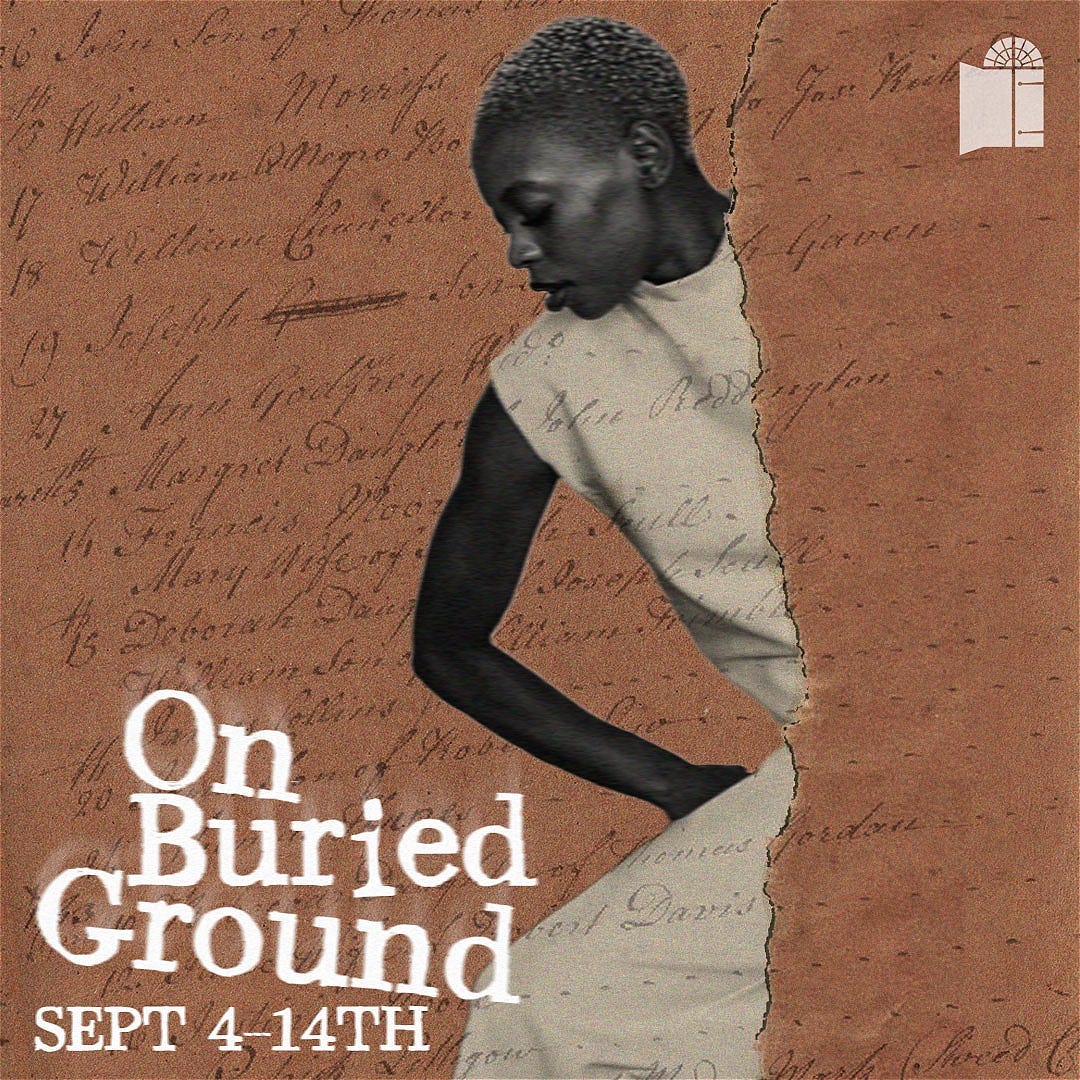
Christ Church Preservation Trust; PWYC; Concluded
In the center of Philadelphia lies the Christ Church Burial Ground, the final resting place to many noble and well-known early Americans. Four of the original signers of the Declaration of Independence can be found in this historic location, including Benjamin Franklin. We walk towards the graveside, with these factoids being told through a speaker system. With two acres of grounds, there are over 1400 grave markers, each honoring the memory of some of the most influential members of the American Revolution. As this announcement repeats, my eye is caught by the sight of a young black woman, dressed in simple undied cloth. She greets us all and begins to recite the same announcement loop, but with one key difference:
“Of the 4000 people buried here, only four were black. All four were children. All four were enslaved. William. Charles. Violet. Sharpers. Find them.”
As the sun gradually sets over the grounds, we explore the grounds to find these children, each seemingly trapped in a loop of playful choreography. Small orbs of light are thrown around the space, playfully lighting up the darkness that we find around us. Witnessing the joy of these young dancers, in the context of their location is striking. Dance artist Shayla Vie-Jenkins, playwright Ang(ela) Bey, and director Nia Benjamin have together created a loving tribute to the true history of our city, but one that refuses to look away from the darkness of our past. Our cast of child performers is supplemented with a second cast, almost an imagining of who these children could have been if they had grown to adulthood. As they dance with each other, to see a new generation of black artists, enacting the ghostly figures of a generation long gone, literally dancing on the graves of former white oppressors, is poetic and truly moving.
On Buried Ground is split into three sections, and so after exploring the burial ground, we are escorted through the cobblestone streets of this historic district by lanternlight to the exhibition “Groundlings” by curator Malkia Okech. An exploration of the black congregants of the historic Christ Church over the 17th and 18th centuries, we can read and listen to artifacts from this period. The final act of the evening takes place in Christ Church itself, here a celebration of the persistence of black joy and hope through the generations. With West African-inspired dance, evolving into step, and folk singing, this scene is striking as the church is transformed from a space of traditional formal worship to something far more joyful yet intertwined with a deep sadness.
We witness a portrayal of “Alice of Dunk’s Ferry” a real congregant of this church, who was one of America’s first great oral historians. An African-American slave, a toll collector, who would later fall into folk legend as a 116-year-old storyteller, this depiction of history was particularly impactful. This woman of little note, gradually made her way to the pulpit of this church, to a place of high honor, to proclaim her story to the enraptured audience. Her memory is treasured through this storytelling, and On Buried Ground honors her tremendously through this.
Site-specific choreography can have a whole host of connotations, and the links between site and show can sometimes be tenuous or stretched thin in immersive productions. Nothing could be further from the truth here, with this church and it’s graveyard being of utmost importance to the production, with both its function and its narrative. History comes alive through this production, and I have found myself looking for more information about this time period, and of these individuals who I met through the show. Through this impactful production, audiences are challenged to come face to face with our shared history, and we leave changed. I can only thank the creative team for this stunning performance, and invitation to learn.
— Edward Mylechreest
Andrew Scharff; PWYC; Concluded
Last year, in this very space, I applauded some works, good, bad, and mixed, for their ability to let me live fully formed dreams. Immersive theatre is special because it lets fantasy intrude into reality, and lets us live scenes that we’ve always felt were true, even if they never existed for us.
I am not an athlete. I won one fencing tournament once, carried on the back of far more talented fencers, and warmed the bench and made flower crowns with my other unathletic friends during my youth soccer matches (could we have guessed I’d turn out gay?). Receiving a Locker Room Pep Talk was solely in the realm of fantasy, to the point that the friend accompanying me burst out laughing at any in-universe references to my athletic prowess. Andrew Scharff not only gets the automatic pass for realizing the scene, but full kudos for making something constantly funny and occasionally touching out of it.
Andrew Scharff is the picture of a coach, in his tracksuit and whistle, and guides the audience (his “team”, although for what sport is never quite specified) through motivational speech after motivational speech, slideshow after slideshow, and gag after gag as the second half of the big game is repeatedly postponed in a Waiting For Godot-esque refrain. The audience sits in a real locker room, crammed in on folding chairs and tiny benches. There is blissfully no stink, but the imaginative audience might sense the ghosts of B.O. and Axe Body Spray lurking. The site specificity is more than a gimmick, with gags both requiring the set-up of a locker room (lockers, narrow little corridors, etc.), and amplified by the fact that everyone is basically piled on top of each other.
Beyond being a laugh a minute, I left feeling absolutely pumped. My day job in medical school is hard, and encouragement is hard to come by in the cutthroat world of competitive grading. Even if it’s a joke, just having someone say “you’re a winner for trying, keep your head in the game, and I believe you can do it” is a treat.
Yes, coach, I’m gonna give it 110%.
— Blake Weil
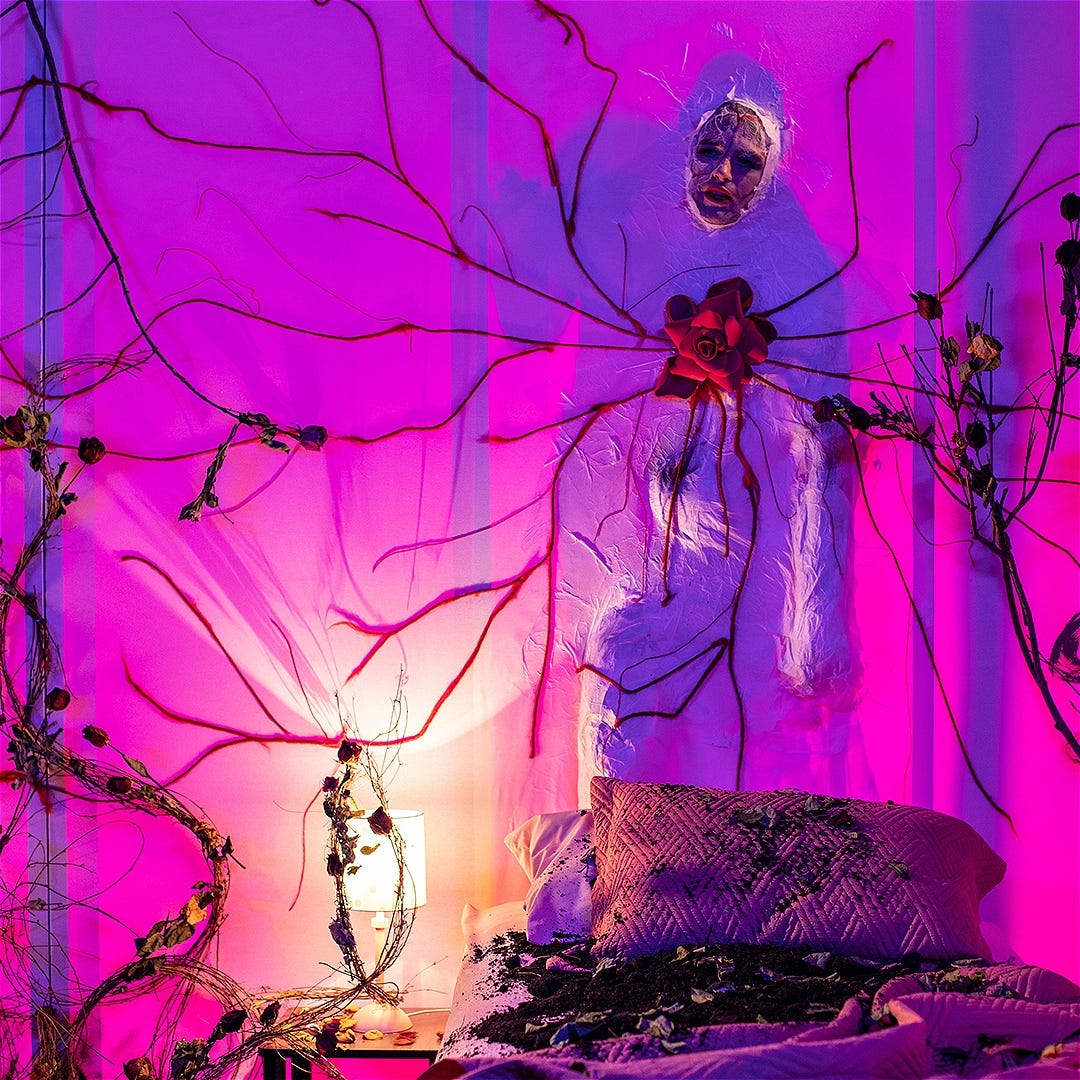
John Jarboe; PWYC; Through Sept. 29
John Jarboe: The Rose Garden is queer psychedelia. It’s camp honesty. It’s sculpture and song and burlesque, a glitter hanky to wipe away the tears. It’s occasionally flawed, navel gazing, and derivative. Most of all though, it is a thrilling and fully realized invitation to step into the creator’s head, and, in a giddy peel of cannibalism, stomach.
The exhibit picks up John’s journey to reckon with her gender as she is informed that she consumed a twin sister Rose in the womb. As such, she plays two characters, her self as she exists in physical reality, and the omnipresent specter of Rose, threatening to subsume her identity. Like a matryoshka, audiences begin the piece nibbling on chocolate fetuses before being nibbled in return, entering the exhibit through John’s giant projected mouth. Once inside, audiences move room by room, exploring immersive sets representative of John’s memories and obsessions, punctuated with projection art and song. Some of these exhibits, such as a wall of “murder evidence” that turns out to be all bagged ephemera of a queer childhood, or a recreation of the bathroom from Psycho, work brilliantly. Others, like the fabled mother’s closet where many queer children first explore gender presentation, are so much sound and fury without really expanding on the symbolism or making it as personal as the rest of the piece. There are joys even in these weaker scenes though, such as a somewhat ill-conceived let down of a coda that still brilliantly parodies The Sound of Music with a tragicomic yet heartwarming use of the sing-a-long format.
Overall, the strengths lie in specificity and the weaknesses in generalities or tropes. John Jarboe is a fascinating artist with a unique story. Vague and obvious activities like a station to “write a letter to your gender” and read others only serve to weaken the piece. This mostly comes across as an attempt to walk a difficult tightrope. John tries to navigate between the often beautiful but occasionally grotesque and macabre piece that would likely land better with an audience more experienced and comfortable with the language, symbolism, and tropes of queer life, and a less ambitious piece that seems to throw its hands up as if to say “gender!” and leave the audience to bring whatever they want to that.
Apart from content, the strength of the fabrication has to be noted: using a variety of mediums, Jarboe creates a textured fantasia that’s a pleasure to rifle through. Poking around the physical space of her brain is a consistent treat, which manages to temper the often heavy subject matter which touches on feelings of dysphoria, rejection, and self loathing.
John Jarboe: The Rose Garden is definitely worth a visit, despite occasional issues. Installation art lets us live in an artist’s vision of the world, and Jarboe’s ability to turn that lens inward is a special, profound talent.
— Blake Weil
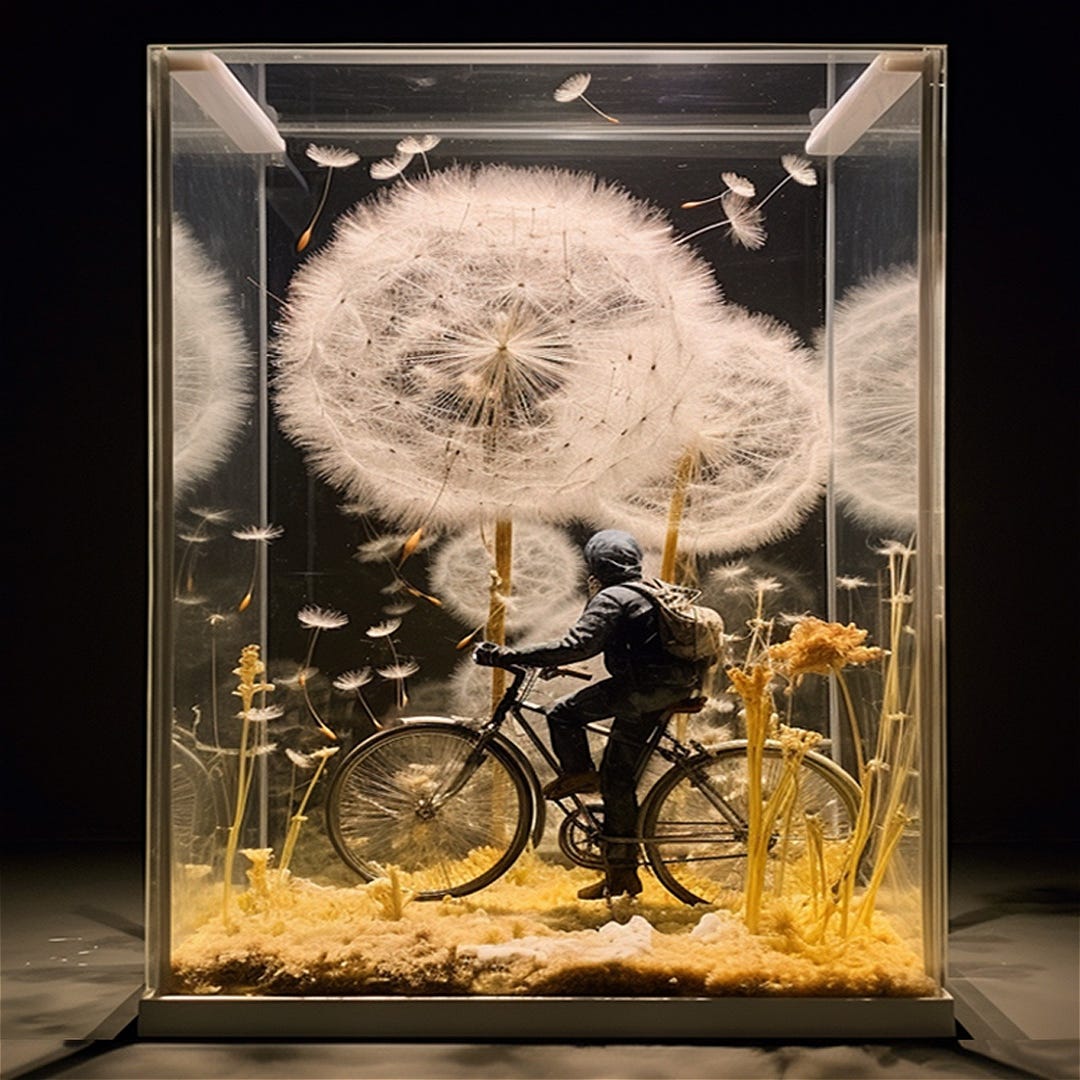
Ghost Ride (or the play that blows away)
Agile Rascal Theater; $30; Through Sept. 22
I gradually regain my balance on the rental bike beneath me and pedal off into the night. I follow a trail of red brake lights, as dozens of other bikes whizz past me on either side. I follow them quietly, through a tunnel. The darkness gives way to a bright light, and I find myself breathless, as I enter into the afterlife.
Agile Rascal Theater has crafted a stunning immersive theater piece, as far away from a traditional theater space as possible. Over the course of two hours, and around four miles of biking along the Martin Luther King Drive, the audience are invited to cycle along the route of the play’s narrative. Together we witness a Latinx bike courier’s ordinary, regular day-to-day life, as he navigates his freedom, political aspirations, and work along his delivery route. With clever use of radio headsets, the cast of characters we come across can speak clearly to us, and as we continue to cycle along the route we hear their conversations, phone calls, and even a SoundCloud demo which may have significance to the romantic aspirations of our subject.
Set pieces are placed along the route, allowing our informal gang of cyclists to join in the journey of labor, perceived privileges, and cycling culture of Philadelphia. As we knock on the door of a young white professional, he just has to tell us how lucky we are to get to cycle all day every day. For the privileged, cycling is a hobby, a pastime, whereas for so many of our nation’s delivery agents and couriers, it is a hard and laborious task. It’s work. This disparity of perspectives feels all the more relevant for us in the audience, as we are on the bikes ourselves.
We follow all this, before we are forced to witness his unfortunate, and untimely death at the hands of a driver who simply wasn’t paying attention. Through tasteful choreography, and a transition to a bright white, and “impossibly light” bike, this moment is hard hitting but beautifully done. From here, we enter into a deeply philosophical take of the afterlife, with fellow “dissolving” cyclists joining our lead, as the parts of him gradually dissipate and fall away. A particularly striking and earnest performance from Miguel Angel Pacheco, as “the biker” helps to land the emotive nature of this second half of the experience. Themes of loss, grief, and memory are of course fully on display here, but with expert delivery from all the performers, it never feels forced or trite, just…beautiful. A late summer breeze cools my face as I cycle along the path, and as the sun sets, and I follow the group into the afterlife, I find myself overwhelmed with emotion.
The production team have smartly teamed up with local bike rental organization, “Indego” to offer a special rental deal for those of us who are not regular cyclists in the city. Finding my footing on a bike after so many years, helped to relay so much of the message of this piece across — we are so fragile, yet so free. While this piece was under construction, the real life tragedy of Philadelphia native Pablo Avendano happened in 2018: a bike messenger was tragically killed while delivering food on Spring Garden. While this piece is not a telling of his story, inspiration has been taken and elements of Pablo have been weaved into the narrative, which is beautifully acknowledged in the program notes and in the pre-show introduction to the piece. The performance I was part of was particularly moving, as members of Pablo’s real life family were in attendance. 10 cyclists were killed in Philadelphia within the last year alone, but through social action, and pressure on local governments, steps to improve safety for cyclists have continued to improve. This piece remains as a memorial, and an acknowledgment of those who have come before us, and who have been lost. As our evening concluded, in place of applause, a peel of bells erupts into the night. A truly moving experience that I will not forget for quite some time.
— Edward Mylechreest
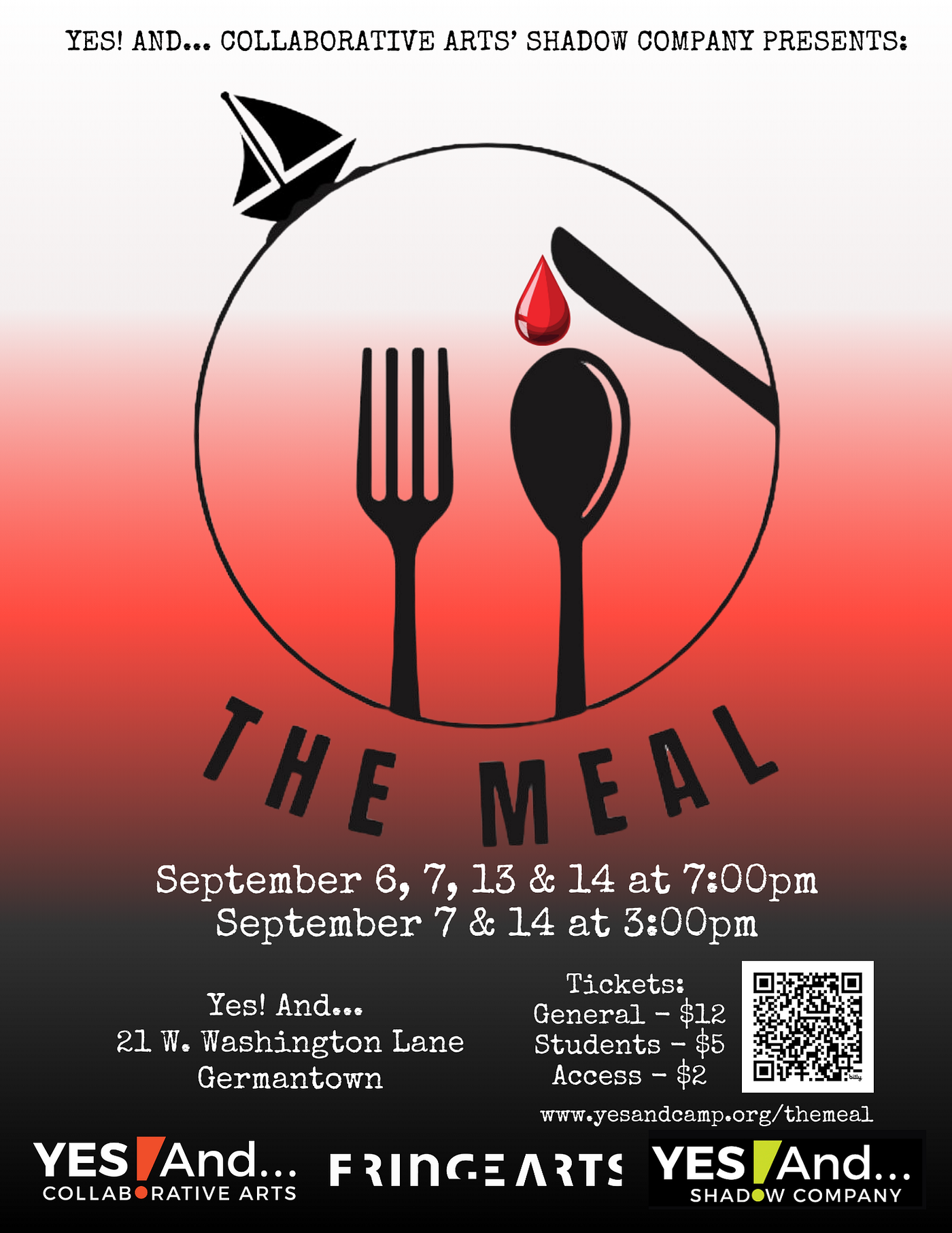
Shadow Company; $12; Concluded
A host of millionaires gather together for a high school reunion on a yacht in the middle of the ocean. Perhaps there is a grudge or two to settle, and there is a continuously beaten-down serving team. No working cell service…what could possibly go wrong?
Shadow Company (Yes… And! Collaborative Arts), is a performing arts company made up of high school students from Philadlephia. With an ensemble-based methodology, they work with a director and professional artists to build their skills as “artists, collaborators, leaders, and citizens”. This talented group of teenage students have gathered together to create this unique piece of theater — which is no small undertaking in itself. The fact that this is an annual tradition, with completely new teams of teens every year, who perform every year as part of the Philly Fringe makes it all the more impressive.
Taking inspiration from recent “eat the rich” media, like “The Menu” or “Triangle of Sadness”, it is clear where the loyalties of this ambitious group of young writers lies. With multiple twists, a murder or two, and even a dream-ballet sequence, there is much to sit back and enjoy in this great youth theatre performance.
What the piece lacks in terms of “immersive” quality, it is really exciting to see a new generation of theater makers wanting to at least reflect their understanding of the term in their creations. Set in untraditional seating, we act almost like the walls of the yacht, staring in and trapping the cast of characters within our space. Interactivity is very basic, but seeing how teens are wanting to engage with this artform is very encouraging to say the least. I was particularly impressed with the level of consent check-in which was undertaken, even for relatively “normal” interaction, shows genuine concern and empathy with audience members — lessons which some of the most established immersive productions could learn from.
Overall we had a wonderful time watching this creative piece, written and performed by a great group of young actors, who I am sure have many bright things ahead in their future — I look forward to being able to say, “I knew them when!”
— Edward Mylechreest
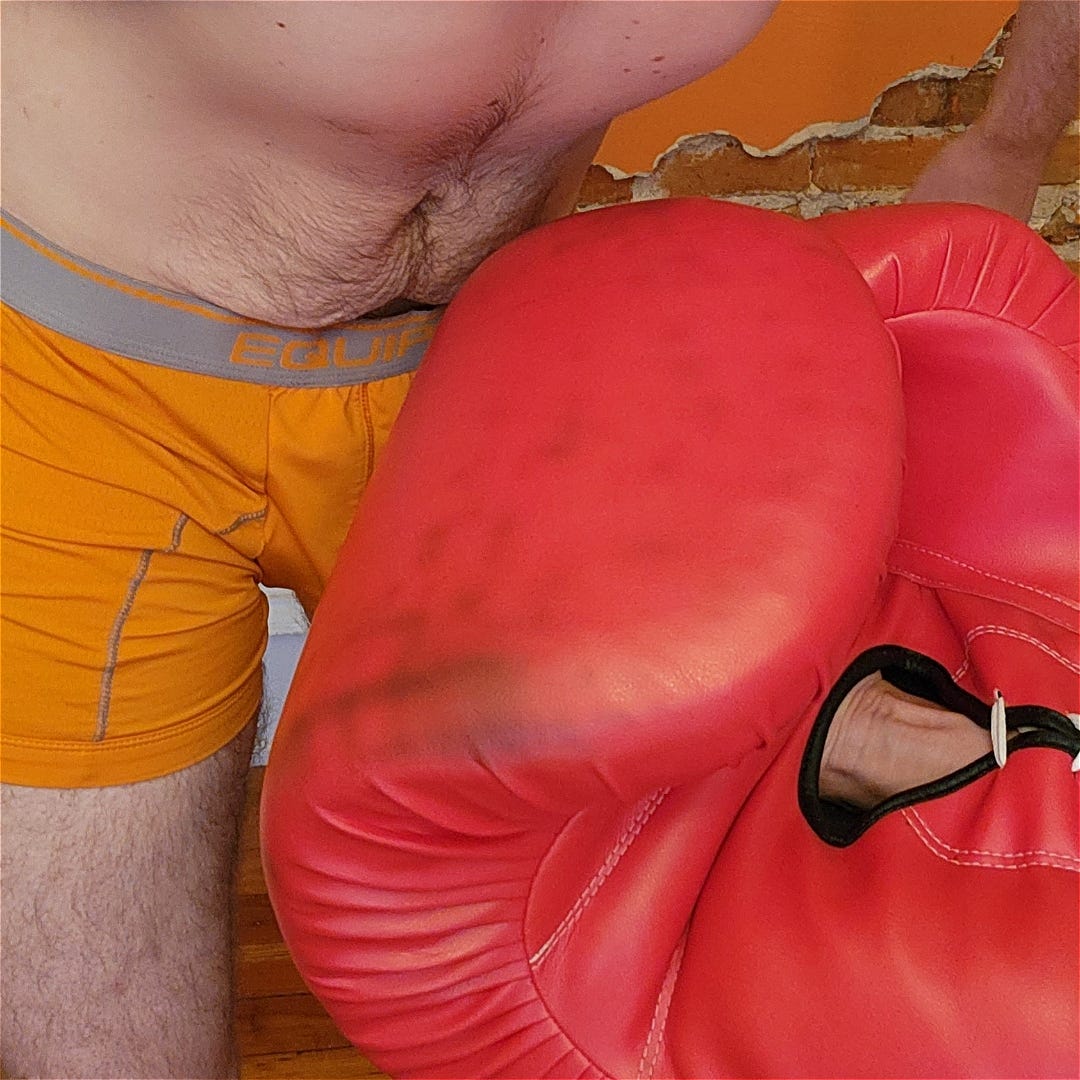
Owen Corey and James Ofalt Punch Each Other in the Dick Until One Submits, Again
Owen Corey and James Ofalt; $20; Concluded
Some immersive shows delight in their mystery, keeping details purposefully shrouded and hidden from its audience members. This is not one of those shows. On a Monday evening, for over an hour, I witnessed two actors continue to punch each other. In the dick. And they kept doing so, until one would finally submit.
An apparent sequel to last year’s Philly Fringe performance, two grown men enter the blackbox stage, dressed in formal attire. Once they take the stage, they derobe and strap on comically oversized boxing gloves.It starts as shocking and striking (pun intended) as you might anticipate, but after the first dozen blows, the (sold out) audience begins to come to grips with the reality that yes, this is what we came to see, and this is what we are going to endure together. There is a strange, and enchanting regularity to it, a rhythm that begins to appear. “Harder!” the crowd begins to yell. Someone yells out “I love Fringe” as the scene continues, to the laughter of the entire room. Through round after round, the laughter turns to uncomfort, to groans, to heckles. I lovingly sparred with the evening and yelled out “use that drama degree!”, to the chuckles of those around me. But in the intimate blackbox space, it was not just the audience who heard me.
Owen and Corey suddenly turn to each other, and an entire impromptu scene takes place. A Southern belle is preparing to kick out a spouse, which of course concludes with… one being punched in the dick. But now the performance has changed, and there is a new air in the room, as the audience have realized something important:hat we say matters.
For the remainder of the evening, suggestions and prompts are given, and they are all taken by our combatants. “Punch in a British accent,” “do a dance,” “tell us how you’re feeling,” “tell us how you’re really feeling,” “sing a song,” “smile,” “let us punch you in the dick.” All are heard, and all are responded with the traditional improvisational response: “yes, and.” I stare open mouthed, as a line forms of audience members, all ready to punch these men… in the dick.
The evening continues to devolve, and hilarity ensues. There is even a shocking “2nd act reveal” that one of the contestants may have been wearing a cup! (or two…. Or three!!). While of course OCAJOPEOITDUOSA, initially comes across as a live action s***-post or meme, there is a surprising amount of depth to be found in this hilarious evening of depravity. It’s so incredibly silly, so truly stupid, but the talented actors on stage continue to adapt and change the performance based on our prompts as an audience.
“Do this again next year” — “Do this again every year” — “Do this again until one of you dies!”
However silly and stupid it might be on stage, it’s because it’s what we, as an audience, asked for. We could have asked them to stop at any point, to finish this barbarity, but instead we asked for more, pleaded for more, demanded more. If you want to enjoy the evening as simple depravity, with hilarity throughout, then that is what it is. Under the surface though, is this a reflection of what contemporary Art and theater has become: a continual response to audience demands. Or perhaps, is it just two men punching each other in the dick?
I’ll conclude with a quote from the evening, which was delivered with all the panache and bravado of a man who had been punching a man in the dick for over an hour:
“You don’t have to stay here, you can all have what you ask for. You deserve what in fact you ask for. Ask for the world, ask for nothing, ask for everything. But you don’t have to stay. While you leave, or stay, or whatever… we’re punching each other in the dick. Until one of us submits.”
Cue massive applause. Save the date for the inevitable return next year.
— Edward Mylechreest
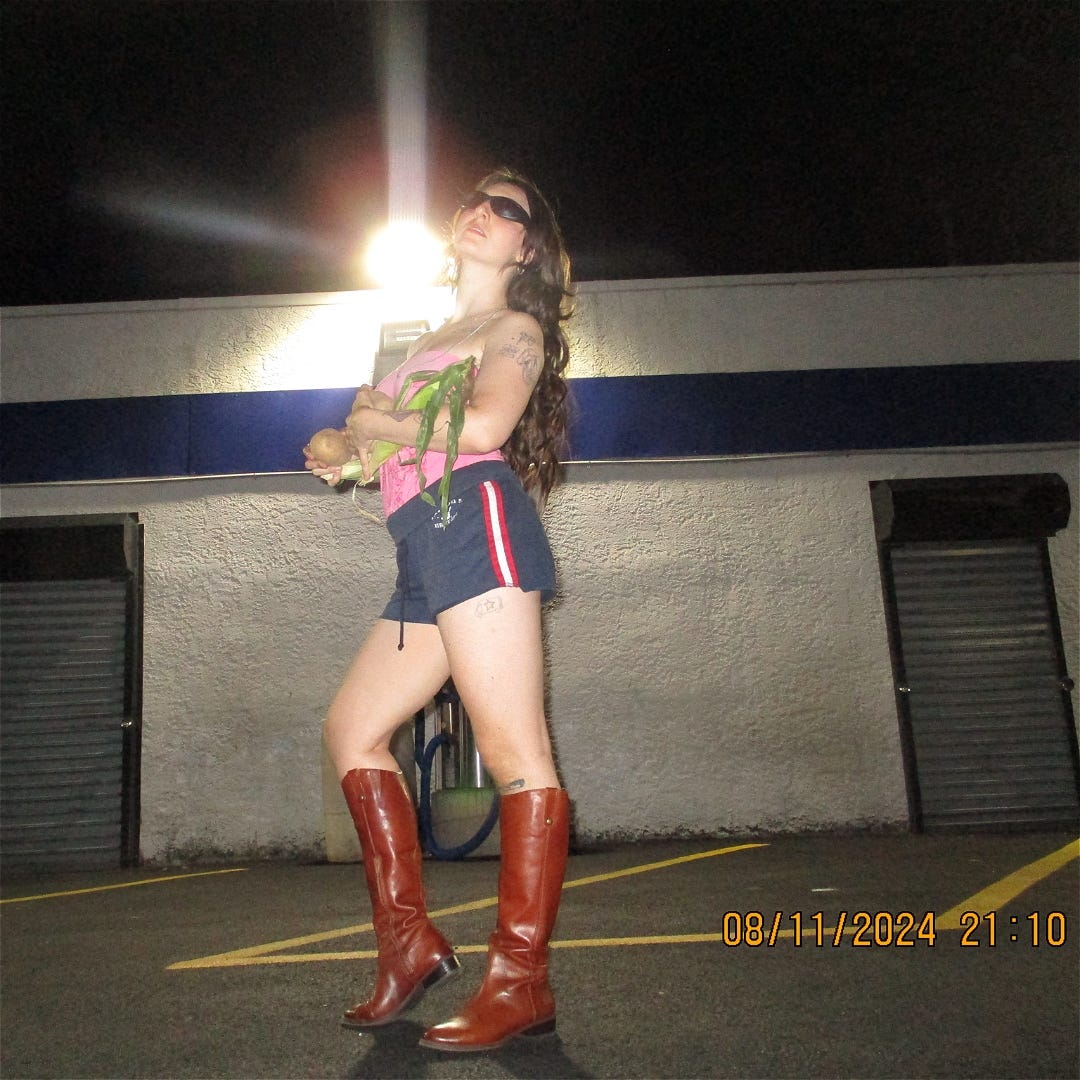
And the skies were not cloudy all day
Gene Farbre; PWYC; Concluded
The difficult thing about immersive theater criticism is that you can’t mentally check out.
Yes, no matter how excited we are sometimes, and mean we are others, journalistic ethics means you have to be the best participant in every show you go to. You have to match the energy and play along as much as you can. Normally, this serves to enhance a piece, and further integrate you into the artist’s vision. Occasionally, though, this means that you are the most uncomfortable participant, and receive the brunt of the emotional and physical pains that a show puts you through.
The piece proceeded as follows, with little to no expectation setting in the promotional materials: there’s going to be a concert, we’re told. The concert is postponed; something isn’t right. We the audience are then arranged into a series of uncomfortable tasks and positions to hold for the next thirty minutes, forming the set and people of a small prairie home. There will be Godot-esque visitor coming for supper, and he does not arrive. We all sing “Home on the Range”. Exit audience.
I suppose we were given what Fabre said in the show description, promising to “give [us] nothing”. But the physical discomfort, all in service of not much, really took away any of the fun to be had in the portrayal of a self-serving, lazy pop princess. I had to crouch for thirty minutes as a sofa. One poor soul spent the evening churning butter.
Can I get that angry? As I said, the show is exactly what it said on the tin. Aggression towards an audience is often welcome in the theater. But at the end of the day, that has to serve a purpose. Skies is merely passive-aggressive, meandering into forgettable disposability.
— Blake Weil
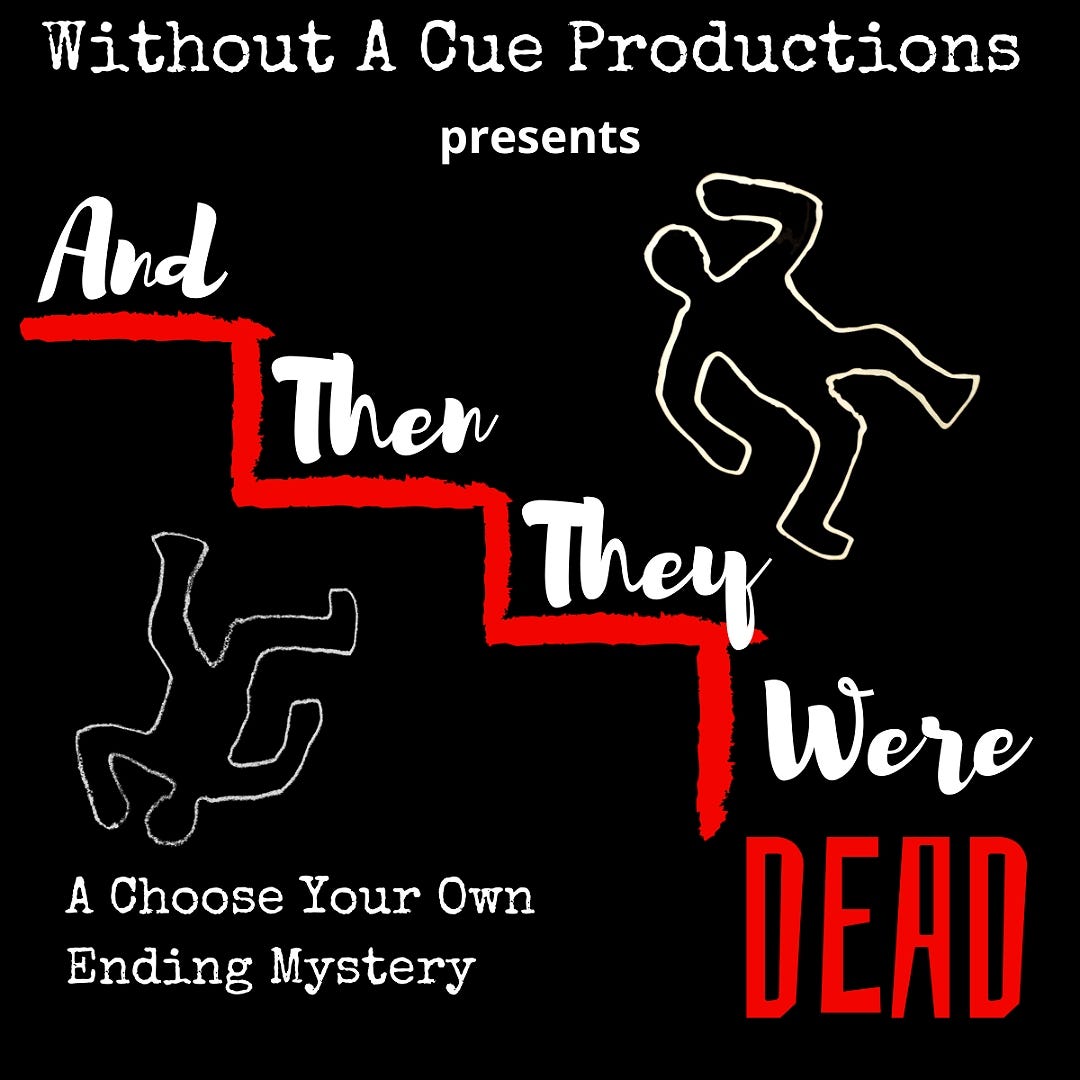
Without a Cue Productions; $25; Concluded
Maria; sometimes, I really owe my plus ones more than the ticket that brings them with me.
I know, both I and the show promised you a comedy murder mystery, and I suppose you got that. There was a murder, and a culprit was brought forward. Yes, there weren’t really clues, or a plot, but at least the start and finish line were there! I know they were shouting every line, but we could hear them (when the overwrought accents didn’t obscure the dialogue)! Yes, the phone voting system to determine the plot direction (or rather, the evening’s casting) only sporadically worked, but they rolled with it!
I agree it was just one joke over and over, that the audience would vote for someone to do something, and they’d be the next character killed, and assume the next role. That did leave certain characters adrift with little to do as they had too few or too many scenes to improv off of their thinly sketched personas, but could we blame the cast for that, or is that the audience’s fault for erratic voting? Well, I mean, I agree with you we could blame the writers, or the lack of rehearsals, or any number of elements.
God, what do you want me to tell the readers about the plot? There really wasn’t one. Not even in the 90 minutes over stated running time. There was maybe a curse? There were maybe a dozen characters, but it’s so hard to tell when they’re all basically the same. I know the main struggle of voting who to kill next was the temptation of having to take your phone out as the show meandered and lazed through the same bit over and over.
I told you over our post-show noodles, Maria, that I like to be merciful at fringe shows, because they’re typically scrappy little experiments. The problem, as you eloquently pointed out, is that this was a production in a tourist trap mystery theater (more an empty-ish room in a Washington Square Park office building) that has somehow found its way into the absolute wrong spotlight. So, Maria, the readers at No Proscenium get our conversation over noodles, unvarnished.
I’m sorry. I promise I’ll take you to a musical next time.
— Blake Weil
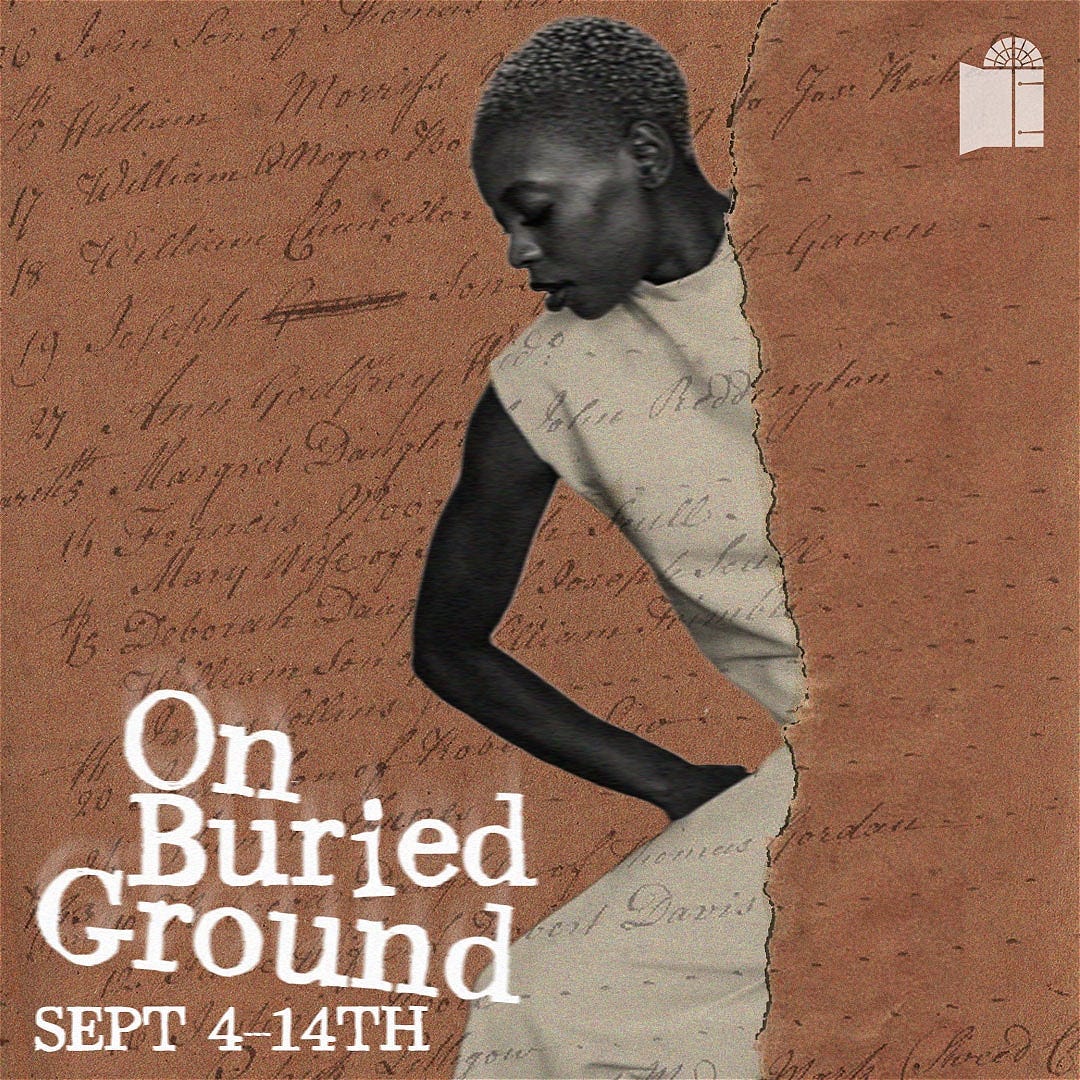
Christ Church Preservation Trust; PWYC; Concluded
In the center of Philadelphia lies the Christ Church Burial Ground, the final resting place to many noble and well-known early Americans. Four of the original signers of the Declaration of Independence can be found in this historic location, including Benjamin Franklin. We walk towards the graveside, with these factoids being told through a speaker system. With two acres of grounds, there are over 1400 grave markers, each honoring the memory of some of the most influential members of the American Revolution. As this announcement repeats, my eye is caught by the sight of a young black woman, dressed in simple undyed cloth. She greets us all and begins to recite the same announcement loop, but with one key difference:
“Of the 4000 people buried here, only four were Black. All four were children. All four were enslaved. William. Charles. Violet. Sharpers. Find them.”
As the sun gradually sets over the grounds, we explore the grounds to find these children, each seemingly trapped in a loop of playful choreography. Small orbs of light are thrown around the space, playfully lighting up the darkness that we find around us. Witnessing the joy of these young dancers, in the context of their location is striking. Dance artist Shayla Vie-Jenkins, playwright Ang(ela) Bey, and director Nia Benjamin have together created a loving tribute to the true history of our city, but one that refuses to look away from the darkness of our past. Our cast of child performers is supplemented with a second cast, almost an imagining of who these children could have been if they had grown to adulthood. As they dance with each other, to see a new generation of Black artists, enacting the ghostly figures of a generation long gone, literally dancing on the graves of former white oppressors, is poetic and truly moving.
On Buried Ground is split into three sections, and so after exploring the burial ground, we are escorted through the cobblestone streets of this historic district by lanternlight to the exhibition “Groundlings” by curator Malkia Okech. An exploration of the Black congregants of the historic Christ Church over the 17th and 18th centuries, we can read and listen to artifacts from this period. The final act of the evening takes place in Christ Church itself, here a celebration of the persistence of Black joy and hope through the generations. With West African-inspired dance, evolving into step, and folk singing, this scene is striking as the church is transformed from a space of traditional formal worship to something far more joyful yet intertwined with a deep sadness.
We witness a portrayal of “Alice of Dunk’s Ferry” a real congregant of this church, who was one of America’s first great oral historians. An African-American slave, a toll collector, who would later fall into folk legend as a 116-year-old storyteller, this depiction of history was particularly impactful. This woman of little note, gradually made her way to the pulpit of this church, to a place of high honor, to proclaim her story to the enraptured audience. Her memory is treasured through this storytelling, and On Buried Ground honors her tremendously through this.
Site-specific choreography can have a whole host of connotations, and the links between site and show can sometimes be tenuous or stretched thin in immersive productions. Nothing could be further from the truth here, with this church and it’s graveyard being of utmost importance to the production, with both its function and its narrative. History comes alive through this production, and I have found myself looking for more information about this time period, and of these individuals who I met through the show. Through this impactful production, audiences are challenged to come face to face with our shared history, and we leave changed. I can only thank the creative team for this stunning performance, and invitation to learn.
— Edward Mylechreest
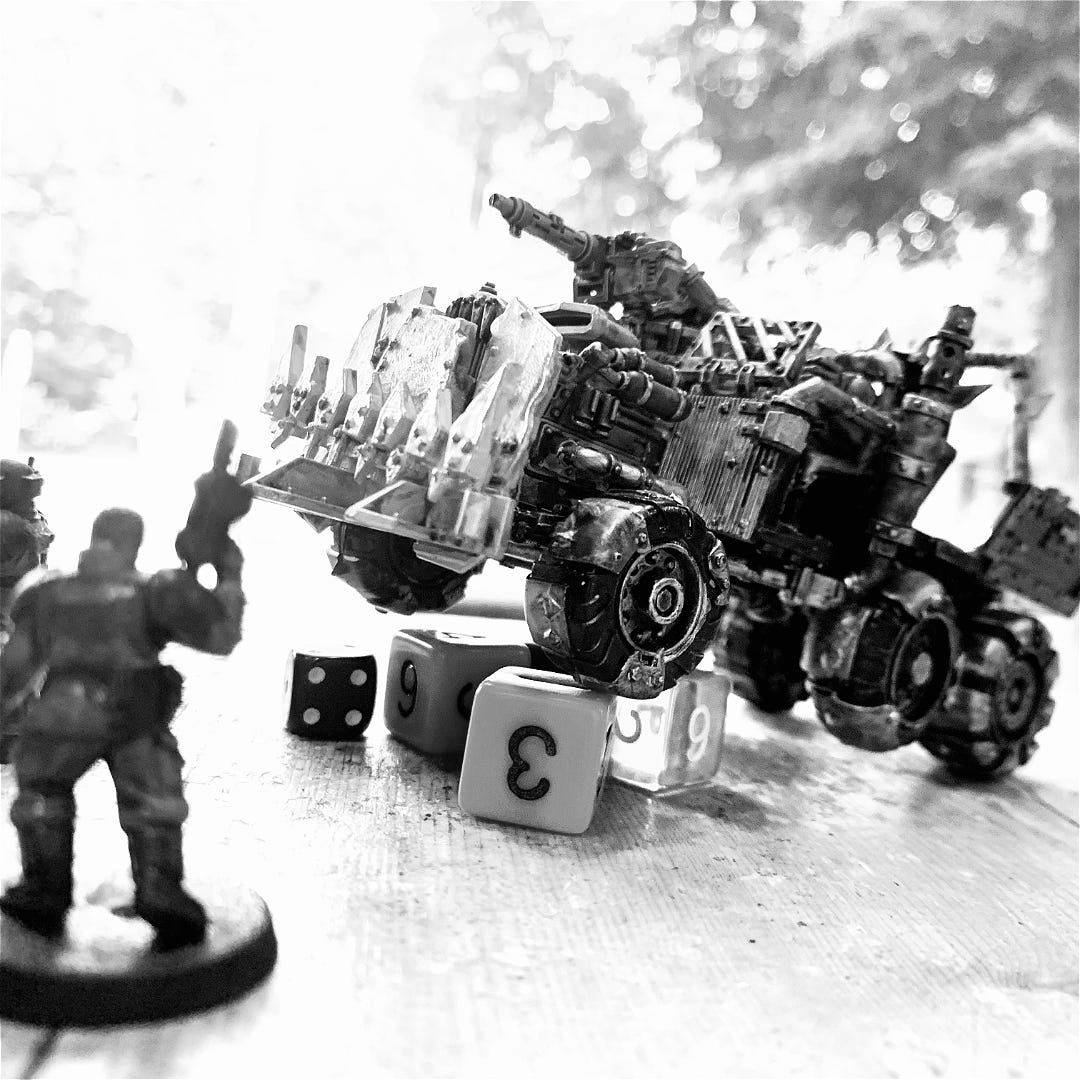
Sam Henderson and Max Henderson; $20; Concluded
It’s a quiet afternoon in the Philly Game Store. Shelves of infinite stories, waiting to be picked up and played, look down at me from the walls as I make my way to the table where a son and father sit waiting for me. They sit making small talk with the other players around the table, a perfectly normal and affable dad, with his quiet and somewhat embarrassed-looking teenage son. The quiet before the storm. The two nemeses look at each other over the battleground, shake hands, and roll to decide who will go first.
There is Only Way is a delightful and intimate look at the relationship of this real-life father and son duo, and the table-top hobby that unites and in other ways separates them. We learn about the factions they are playing, but more importantly, we learn about the reasons they picked these factions, the meaning that they have to each of them, and what this game represents to the two of them as individuals, and to their relationship:
“I think it’s called Warhammer 40k because only people in their 40’s are still interested in it”
The father plays as the human marine faction, a potentially simple choice he admits, but one that quickly leads us down a rabbit hole of discussing American imperialism, capitalism, and the want to play make-believe fascism being all the more present in a time like this where science fiction seems to become more like reality day after day. The son plays with the Orks, a species who belief in something enables it to be and to succeed — the belief in the purpose and matter of something, makes it so. What started as just a TTRPG, has become something of a hilarious philosophical debate.
As they take turns, they interact with the others at the table in a variety of ways. One particularly moving moment comes from seeing the “real” reasons why they are playing, being shown to us silently on the back of the notecards that also act as rule reminders. While we hear the minutia of rule lawyering being explained by one, we see the joy and love from the other in the way that they share with us privately. We touch on themes of maturity, family dynamics, and the desperate need to connect.
Towards the end of our show, it is clear that the game on the table is nothing more than an excuse for the duo to spend time together, and that there is far more joy to be found around the table than on it. Dice are thrown haphazardly (much to the chagrin of one of my fellow attendees), and chaos starts to ensue. No longer is this a game about rules, but one about personal responsibility and individual stories. Two veteran soldiers are thrown into my hands::
“What if this is their last moment together? How would they feel? What has been left unsaid for so many years on the battlefield??”
I cradle the two friends, companions, even lovers, and jump straight into the make-believe. That in a time such as this, even amongst the chaos of the battlefield of life that surrounds us, play is what we need to connect with one another, and sometimes it is what we need to survive.
I adored my time at the table with this talented, real-life, father-and-son duo. I will gladly recommend anyone join them for a future session of war gaming, chaos, destruction, and gentle familial bonding
— Edward Mylechreest
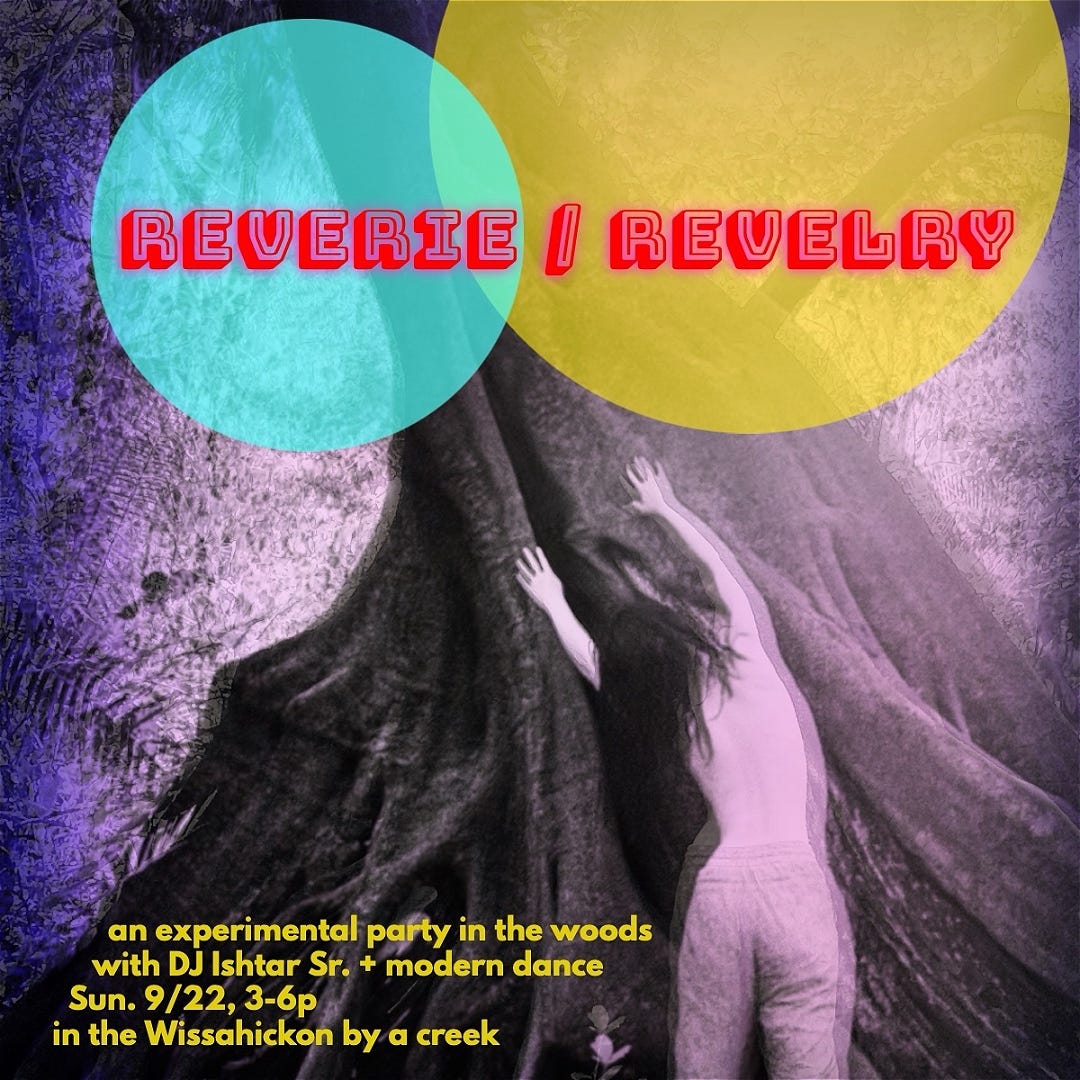
Vivian Lehrer; $25; Concluded
In the middle of Wissahickon Park, a short hike from the nearest parking lot, there is a creek. Here modern dancers take inspiration from nature, creation, and the audience to create immersive work together, improvising to a curated score by DJ Ishtar Sr.
Unfortunately, in reality, in Wissahickon Park there is a poorly organized dance improv session, that started over 30 minutes late, issues with the DJ equipment, and with no clear direction or inspiration other than “nature”.
Clearly, there were some gifted dancers involved in the project, but it was clear that this was a “come and see what we make together” operation, rather than anything that had structure or pre-planning at all. Audience members were confused, lost, and left as quickly as they came.
Immersive in that I was surrounded by nature, but unfortunately I gained far more from the walk back to the car than I did at the “show”.
— Edward Mylechreest
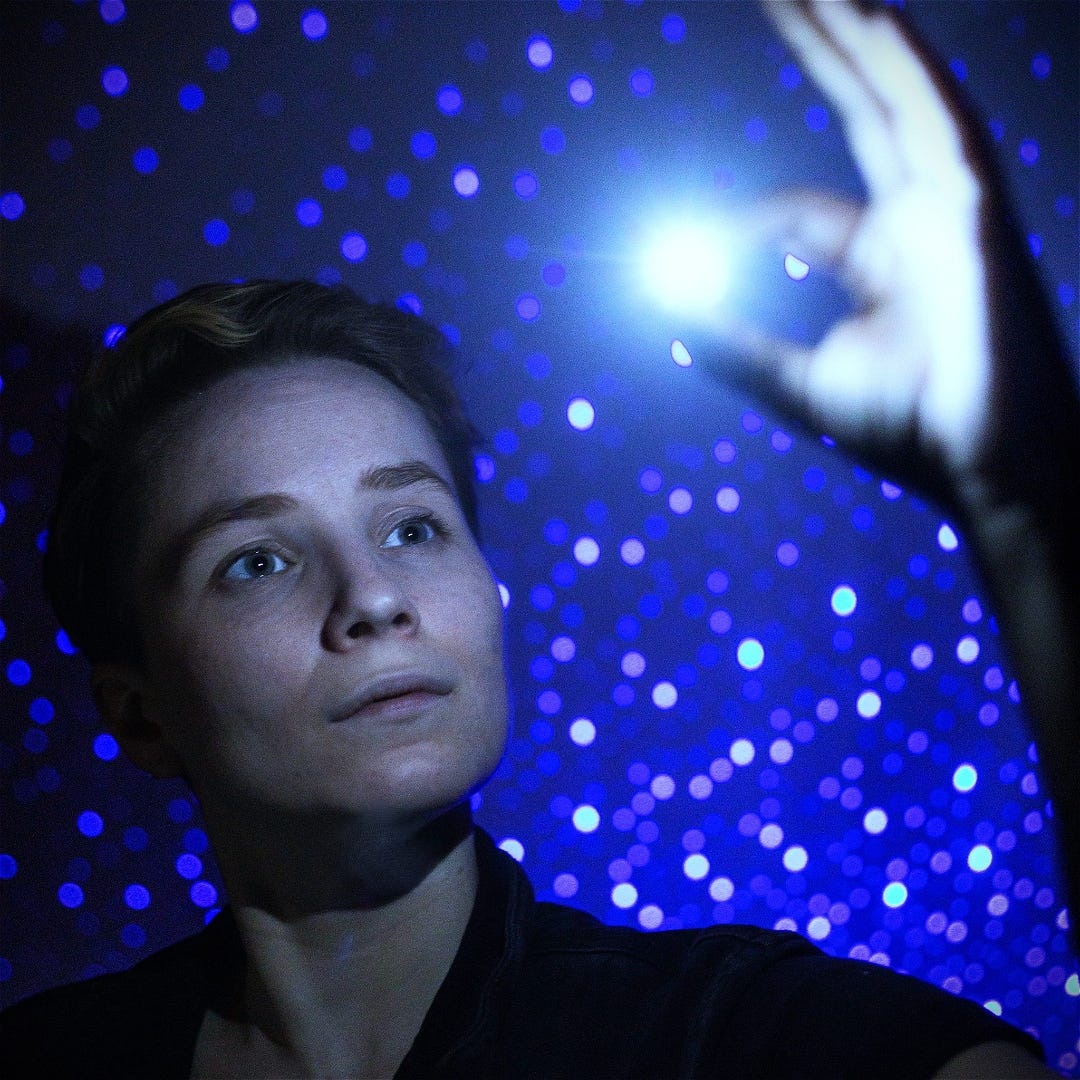
Grief Astronomer
Vivian Lehrer; $25; Concluded
The line between performance and reality is often highly blurred in immersive works, and the exquisite “performance” of Laurel Johnson in their touching and therapeutic piece, Grief Astronomer highlights this in one of the finest one-performer shows I have ever seen.
With the presence of a public library kindergarten storytelling teacher, we meet Laurel as they invites us to join her on a voyage back to earth. Sitting on pillows and blankets in the simple black box theater space, we create the sounds of the engine with our feet, and we blast off into space. Immediately we are all invited to join in on the play of this piece together, with childlike wonderment we begin our journey together.
As a child, Johnson had always been fascinated by space. Born just after it’s launch, she links much of her life to that of the Hubble Space Telescope. True a modern marvel, but it contained a flaw, an error with it’s mirror that while it could not have been predicted, would forever be seen as a mistake by it’s creators. We quickly go full throttle into the life and struggles of a talented young person, lifted up by their parents before being forced to turn from them, battling against disability, abuse, PTSD, long covid, neurological disease, trauma, so much so driving the performer to try to take their own life on multiple occasions. There is so much grief that we all battle through, but this autobiographical presentation feels so raw, real and relatable.
Told through movement, co-creation, blanket forts, and wonderful light and visual presentation, Grief Astronomer is more than a trajedy. It is a symbol of hope, of resilience, of strength. When in the face of such chaos, creation is clearly something that this talented writer and performer has been forced to turn to to help them process it all. The show quickly turns it’s gaze to the audience, and we in turn find meaning in the madness of it all.
With clever use of tone and pacing, we are able to hit these hard themes and topics without shying away, but then able to pivot to the frivolity and beauty of child like creation. Throw in high level astronomy and physics factoids, and I am open mouthed staring up at the projections of the trillions of stars that represent where we are and where have come from. It all works so marvelously well together, an amalgamation of all that is processing grief, through a highly entertaining and educational show.
Johnson is currently touring Grief Astronomer around the United States, and I highly recommend anyone, who is in the right frame of mind to deal with the topics covered, attend this beautifully poignant piece of therapeutic theater. So much more than a survivor, this talented perfomer is thriving through sharing their work with the public. I not only applaud them for their bravery, but for this delightful show.
— Edward Mylechreest
Discover the latest immersive events, festivals, workshops, and more at our new site EVERYTHING IMMERSIVE, home of NoPro’s show listings.
NoPro is a labor of love made possible by our generous Patreon backers. Join them today and get access to our Newsletter and Discord!
In addition to the No Proscenium website and our podcast, and you can find NoPro on Facebook, LinkedIn, YouTube, Instagram, and in the Facebook community also named Everything Immersive.